Removing the air plug from the heating system: how to properly bleed air from radiators?
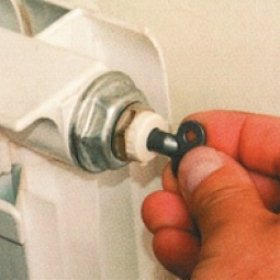
Air in the heating system is an obstacle to its normal functioning. Residents of apartments and houses face this problem, as a rule, at the beginning of the heating season. Noise in the pipes, cold batteries, corrosion of metal elements - this is the result of the formation of air jams. And this happens even with a perfectly designed and properly installed heating system. Why this happens and why it is necessary to timely remove air from the heating system - this will be discussed in this article.
Why does air appear in the heating system?
Many of our compatriots are familiar with the concept of “traffic jams”. This phenomenon is remembered at the beginning of the heating season, when heat is released into houses, and in apartments on the upper floors, often the batteries do not heat up or heat up only in the lower part, and in the upper one they are absolutely cold. Where does the air come from in the pipelines? There may be several reasons for airing:
- carrying out repair work (assembly, disassembly of the pipeline), during which the appearance of air is inevitable;
- non-observance during installation of the magnitude and direction of the slope of the pipelines;
- lowered water pressure: the water level drops, and the voids formed as a result of it are filled with air;
- when water is heated, bubbles of the air contained in it are released and rise to the upper part of the pipeline, creating air jams there;
- the heating system is filled incorrectly: after summer downtime, pipes should not be filled with water quickly, but slowly, while simultaneously venting the heating system;
- poorly sealed pipe joints through which coolant leaks. Leak in these places is hardly noticeable, since hot water immediately evaporates. It is through loose seams that air is sucked into the system;
- malfunction of air intake devices;
- water connectionwarm floor»To the heating system, the pipes of which are installed at different heights during installation.
Air Removal Methods
Since one or more of the listed factors can be present in many houses, the question of air removal in the heating system necessarily arises. This operation can be performed in various ways. It all depends on what kind of coolant circulation we are dealing with - natural or forced.
IN natural circulation heating system (referring to the upper piping), the resulting air plug can be removed through the expansion tank - it is at the highest point in relation to the entire system. With lower piping, air is removed in the same way as in heating systems equipped with circulation pump.

It is possible to bleed air from the heating system with natural circulation using an expansion tank
In heating systems with forced circulation of the coolant at the highest point, an air collector is installed specifically designed for venting. In this case, the supply pipe is laid with a rise in the direction of movement of the coolant, and air bubbles rising along the riser are removed through the air taps (they are installed at the highest points). In all cases, the return pipe must be laid with a slope in the direction of the water drain for accelerated emptying if repair is necessary.
Types of air vents and their installation locations
Air vents are manual and automatic. Manual air vents or Mayevsky taps are small. They are usually installed on the end of the heating radiator. Adjust the Mayevsky crane with a wrench, screwdriver or even manually. Since the tap is small, its performance is small, therefore, it is used only for local elimination of air congestion in the heating system.
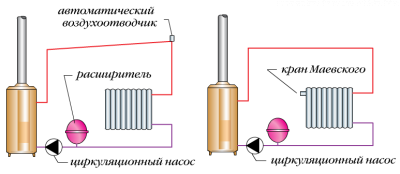
Air vents for the heating system are of two types: manual (Mayevsky crane) and automatic (work without human intervention).
The second type of air vents - automatic - work without human intervention. They are installed both in a vertical position and in a horizontal position. They have high performance, but have a sufficiently high sensitivity to pollution in the water, so they are mounted together with filters on the supply pipelines and on the return.
Automatic air vents are installed in closed heating systems through pipelines at different points. Then the air discharge from each group of devices is carried out separately. A multi-stage dewatering system is considered the most effective. With proper installation and proper installation of pipes (under the desired slope), it will be simple and trouble-free to ventilate air through the air vents. The removal of air from the heating pipes is associated with an increase in the flow rate of the coolant, as well as with an increase in pressure in them. A drop in water pressure indicates a violation of the tightness of the system, and temperature differences indicate the presence of air in the heating radiators.
Determination of the place of formation of the cork and its removal
How can I understand that there is air in the radiator? Extraneous sounds, such as gurgling, or water leaking, usually indicate the presence of air. To ensure full circulation of the coolant, it is necessary to remove this air. With full airing of the system, you first need to determine the places of formation of traffic jams by tapping the heating devices with a hammer. Where there is air congestion, the sound will be more sonorous and stronger. Air is collected, as a rule, in radiators installed on the upper floors.
Having realized that air is present in the heater, you should take a screwdriver or a wrench and prepare a water tank. Having opened the thermostat to the maximum level, you need to open the valve of the Mayevsky crane and substitute the tank. The appearance of a slight hiss will mean that the air comes out. The valve is kept open until water flows and only then close.
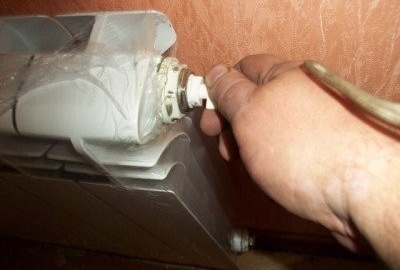
Elimination of the air plug in the heating battery using a Mayevsky tap installed on it: the valve is opened with a special key or manually and kept open until water appears
It happens that after this procedure, the battery heats up briefly or not well enough. Then it must be purged and washed, since the accumulation of debris and rust in it can also cause air to appear.
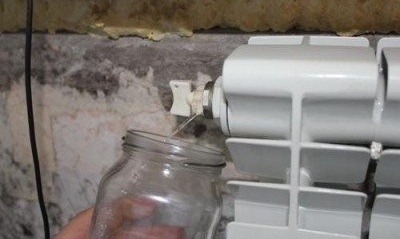
If the battery still does not heat up well after venting, try draining about 200g of coolant to make sure the air plug is completely removed.If it doesn’t help, but it is necessary to blow and rinse the radiator from possibly accumulated dirt
If after that there are no improvements, you need to check the fill level of the heating system. Air plugs can also form on bends in pipelines. Therefore, it is important during the installation process to observe the direction and size of the slopes of the distribution pipelines. In places where the slope for any reason differs from the project, air vent valves are additionally installed.
In aluminum radiators, air congestion forms more intensively due to poor material quality. As a result of the reaction of aluminum with the coolant, gases are formed, so they must be regularly removed from the system. In such situations, it is recommended to replace aluminum radiators with instruments of better materials with an anti-corrosion coating and install air vents. In order for the room heating to be normal, before filling the heating system with water, it is necessary to take timely care to remove air from it that impedes the normal movement of the coolant, and then in the winter it will be warm and comfortable in your house.
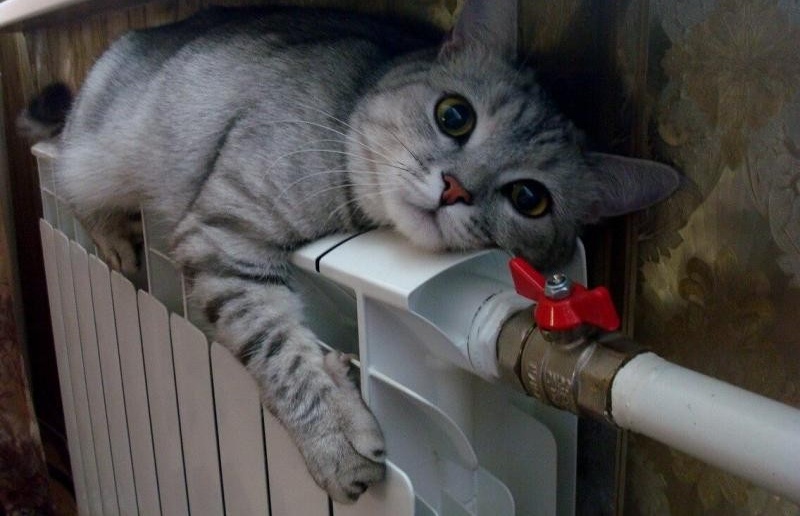
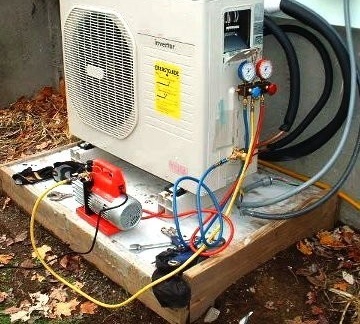
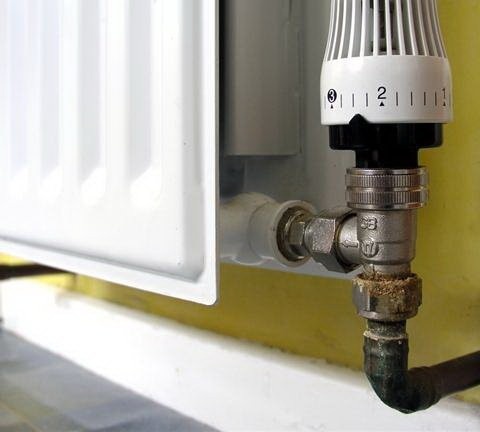
12 comments